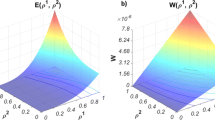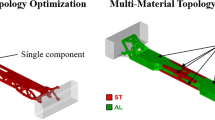Abstract
Multi-material topology optimization has become a popular design optimization discipline since it allows to go a step further in topology optimization of the design of lightweight components and structures. However, it also presents additional challenges in terms of managing a higher complexity in the optimization problem, reliably estimating the manufacturing cost taking into account the cost of joining dissimilar materials, or assessing the manufacturability of the design. This paper proposes a set of methods that solve generic multi-material topology optimization problems, while including several novel aspects such as a comprehensive cost model, specific design rules for multi-material design, and model order reduction techniques to improve the computational efficiency. Two different examples, consisting of a sitting bench and a car cowling, have been solved in order to support the benefits of the approach.



















Similar content being viewed by others
References
Agrawal M (2007) On including manufacturing constraints in the topology optimization of surface-micromachined structures. 7th World Congress on Structural and Multidisciplinary Optimization
Altair O (2020) Altair Engineering, Inc. https://www.altair.com/optistruct/https://www.altair.com/optistruct/
Amir O, Stolpe M, Sigmund O (2010) Efficient use of iterative solvers in nested topology optimization. Struct Multidiscip Optim 42(1):55–72
Asadpoure A, Guest JK, Valdevit L (2015) Incorporating fabrication cost into topology optimization of discrete structures and lattices. Struct Multidiscip Optim 51(2):385–396
Beghini LL, Beghini A, Katz N, Baker WF, Paulino GH (2014) Connecting architecture and engineering through structural topology optimization. Eng Struct 59:716–726
Bendsøe M, Sigmund O (2003) Topology optimization: theory, methods and applications. Springer, Berlin
Bendsøe MP, Kikuchi N (1988) Generating optimal topologies in structural design using a homogenization method. Computer Methods in Applied Mechanics and Engineering 71(2):197– 224
Bobby S, Spence SMJ, Kareem A (2016) Data-driven performance-based topology optimization of uncertain wind-excited tall buildings. Struct Multidiscip Optim 54(6):1379–1402
Brand M (2006) Fast low-rank modifications of the thin singular value decomposition. Linear Algebra Appl 415(1):20–30
Burggraeve S, López C, Stroobants J (2020) Quantifying compactness and connectivity in multimaterial designs. International Mathematical Forum 15(1):1–23
Cavazzuti M, Baldini A, Bertocchi E, Costi D, Torricelli E, Moruzzi P (2011) High performance automotive chassis design: a topology optimization based approach. Struct Multidiscip Optim 44(1):45–56
CES-Selector (2018) Granta design. https://grantadesign.com/industry/publications/white-papers/
Chiandussi G, Gaviglio I, Ibba A (2004) Topology optimisation of an automotive component without final volume constraint specification. Adv Eng Softw 35(10):609–617
Cui M, Chen H, Zhou JA (2016) Level-set based multi-material topology optimization method using a reaction diffusion equation. Comput Aided Des 73:41–52
Dienemann R, Schumacher A, Fiebig S (2017) Topology optimization for finding shell structures manufactured by deep drawing. Struct Multidiscip Optim 56(2):473–485
Falkenberg P, Franke T, Fiebig S, Vietor T (2015) Consideration of adhesive joints for a multi-material topology optimization approach. 20th International Conference on Composite Materials, ICCM 2015, Code, 138792
Geoff D (2003) Materials for automobile bodies. Butterworth-Heinemann, Oxford
Gersborg AR, Andreasen CS (2010) An explicit parameterization for casting constraints in gradient driven topology optimization. Struct Multidiscip Optim 44(6):875–881
Gogu C (2015) Improving the efficiency of large scale topology optimization through on-the-fly reduced order model construction. Int J Numer Methods Eng 101(4):281–304
Held A, Nowakowski C, Moghadasi A, Seifried R, Eberhard P (2016) On the influence of model reduction techniques in topology optimization of flexible multibody systems using the floating frame of reference approach. Struct Multidiscip Optim 53(1):67–80
Jang G-W, Kim KJ, Kim YY (2008) Integrated topology and shape optimization software for compliant MEMS mechanism design. Adv Eng Softw 39(1):1–14
Jang G-W, van Dijk NP, Van Keule F (2012) Topology optimization of MEMS considering etching uncertainties using the level-set method. Int J Numer Methods Eng 92(6):571–588
Jensen JS (2007) Topology optimization of dynamics problems with padé approximants. Int J Numer Methods Eng 72(13):1605– 1630
Kim SY, Kim IY, Mechefske CK (2012) A new efficient convergence criterion for reducing computational expense in topology optimization: reducible design variable method. Int J Numer Methods Eng 90(6):752–783
Kleemann S, Fröhlich T, Türck E, Vietor TA (2017) Methodological approach towards multi-material design of automotive components. Procedia CIRP 60:68–73
Krog L, Tucker A, Kemp M, Boyd R (2004) Topology optimization of aircraft wing box ribs. 10th AIAA/ ISSMO Multidisciplinary Analysis and Optimization Conference 3:2020–2030
Lei L, Kapil K (2014) Two-point gradient-based MMA (TGMMA) algorithm for topology optimization. Computers & Structures 131:34–45
Leohold J (2009) Pathways for a sustainable automotive future in Europe. International Conference Innovative Developments for Lightweight Vehicle Structures
Li D, Kim IY (2018) Multi-material topology optimization for practical lightweight design. Struct Multidiscip Optim 58(3):1081–1094
Liang X, Du J (2019) Concurrent multi-scale and multi-material topological optimization of vibro-acoustic structures. Computer Methods in Applied Mechanics and Engineering 349:117– 148
Liu J, Ma Y (2016) A survey of manufacturing oriented topology optimization methods. Adv Eng Softw 100:161–175
Liu K, Tovar A (2014) An efficient 3D topology optimization code written in Matlab. Struct Multidiscip Optim 50(6):1175–1196
López C, Baldomir A, Hernández S (2016) Deterministic versus reliability-based topology optimization of aeronautical structures. Struct Multidiscip Optim 53(4):907–921
López C, Burggraeve S, Stroobants J (2018) A preliminary approach to multi-material topology optimization considering cost estimation. WIT Transactions on the built environment. International Conference on High Performance and Optimum Design of Structures and Materials 2018 175:121–131
MATLAB R2017a (2018) Mathworks. https://nl.mathworks.com/help/
Mhapsekar K, McConaha M, Anand S (2018) Additive manufacturing constraints in topology optimization for improved manufacturability. J Manuf Sci Eng 140(5):1–16
Mirzendehdel AM, Suresh KA (2015) Pareto-optimal approach to multimaterial topology optimization. ASME J Mech Des 137(10):101701
Nigro PSB, Simões ET, Pimenta PM, Schröder J (2019) Model order reduction with Galerkin projection applied to nonlinear optimization with infeasible primal-dual interior point method. International Journal for Numerical Methods in Engineering
Ramani AA (2010) Pseudo-sensitivity based discrete-variable approach to structural topology optimization with multiple materials. Struct Multidiscip Optim 41(6):913–934
Remouchamps A, Bruyneel M, Fleury C, Grihon S (2011) Application of a bi-level scheme including topology optimization to the design of an aircraft pylon. Struct Multidiscip Optim 44(6):739– 750
Rozvany GIN (2009) A critical review of established methods of structural topology optimization. Struct Multidiscip Optim 37(3):217–237
Shanbin L, Honggang M, Li X, Wenjie Z (2019) Lightweight design of bus frames from multi-material topology optimization to cross-sectional size optimization. Eng Optim 51(6):961–977
Sørensen S, Lund E (2013) Topology and thickness optimization of laminated composites including manufacturing constraints. Structural and Multidisciplinary Optimization 48(2):249–265
Svanberg K (1987) The method of moving asymptotes-a new method for structural optimization. Int J Numer Methods Eng 24(2):359–373
van Dijk NP, Maute K, Langelaar M, van Keulen F (2013) Level-set methods for structural topology optimization: a review. Struct Multidiscip Optim 48(3):437–472
Vatanabe SL, Lippi TN, de Lima CR, Paulino GH, Silva ECN (2016) Topology optimization with manufacturing constraints: a unified projection-based approach. Adv Eng Softw 100:97–112
Wang S, de Sturler E, Paulino GH (2007) Large-scale topology optimization using preconditioned Krylov subspace methods with recycling. Int J Numer Methods Eng 69(12):2441–2468
Woischwill C, Kim IY (2018) Multimaterial multijoint topology optimization. Int J Numer Methods Eng 115(13):1552–1579
Xia Q, Shi T, Wang MY, Liu SA (2010) Level set based method for the optimization of cast part. Struct Multidiscip Optim 41(5):735–747
Xie X, Zheng H, Jonckheere S, Desmet W (2019) Explicit and efficient topology optimization of frequency-dependent damping patches using moving morphable components and reduced-order models. Comput Methods Appl Mech Eng 355:591–613
Yin L, Ananthasuresh GK (2001) Topology optimization of compliant mechanisms with multiple materials using a peak function material interpolation scheme. Struct Multidiscip Optim 23(1):49–62
Yin L, Ananthasuresh GK (2012) Multi-material topology optimization of laminated composite beam cross sections. Compos Struct 94(11):3278–3289
Yoon GH (2010) Structural topology optimization for frequency response problem using model reduction schemes. Comput Methods Appl Mech Eng 199(25):1744–1763
Zhu J, Chen X (2017) An engineering constraint method for continuum structural topology optimization. Advances in Mechanical Engineering 9(12):1–6
Zhuang C, Xiong Z, Ding H (2010) Topology optimization of multi-material for the heat conduction problem based on the level set method. Eng Optim 42(9):811–831
Zuo K-T, Chen L-P, Zhang Y, Yang J (2006) Manufacturing-and machining-based topology optimization. The International Journal of Advanced Manufacturing Technology 27:531–536
Zuo K-T, Chen L-P, Zhang Y-Q, Yang J (2007) Study of key algorithms in topology optimization. The International Journal of Advanced Manufacturing Technology 32(7):787–796
Zuo W, Saitou K (2017) Multi-material topology optimization using ordered SIMP interpolation. Struct Multidiscip Optim 55(2):477–491
Acknowledgments
This study was performed in the frameworks of the OPTIMULTI ICON project. https://www.flandersmake.be/en/projects/optimulti.
Funding
This research was supported by Flanders Make, the strategic research centre for the manufacturing industry. The Research Fund KU Leuven provided support. The research of S. Jonckheere is funded by a grant of the Flanders Innovation & Entrepreneurship Agency.
Author information
Authors and Affiliations
Corresponding author
Ethics declarations
Conflict of interest
The authors declare that they have no conflict of interest.
Additional information
Responsible Editor: Julián Andrés Norato
Publisher’s note
Springer Nature remains neutral with regard to jurisdictional claims in published maps and institutional affiliations.
Replication of results
The results presented in this article can be replicated by implementing in MATLAB the methods and algorithms detailed in Sections 2, 3, 4, and 5.
Rights and permissions
About this article
Cite this article
López, C., Burggraeve, S., Lietaert, P. et al. Model-based, multi-material topology optimization taking into account cost and manufacturability. Struct Multidisc Optim 62, 2951–2973 (2020). https://doi.org/10.1007/s00158-020-02641-0
Received:
Revised:
Accepted:
Published:
Issue Date:
DOI: https://doi.org/10.1007/s00158-020-02641-0




